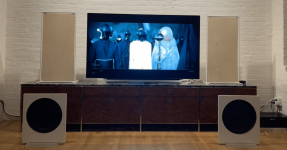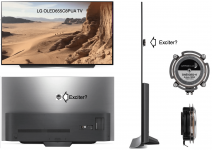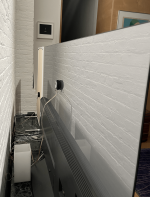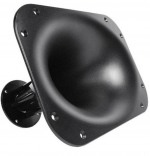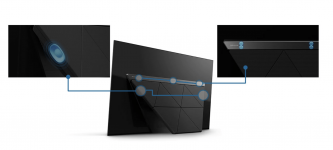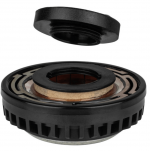Well, I am not going to buy that speaker for that money, only Youtube influencers (and anti-influencers) can do that, as that's their paycheck.Chdsl.
It looks very similar but bigger to the one you showed earlier.
The organic glass sounds like plastic as demonstrated in this video ?
Steve.
Anyway, I did a little experiment with 2 exciters and 20mm thick 70cm x 40cm EPS70 untreated sheet. That's the only sheet I have at home. First with one exciter, placing the thin edge (20mm) on the exciter, sheet held tightly vertically. The sound was better on the longer side. It didn't matter, if the exciter was in the middle or near the end, that is, while the music was playing, I pushed it left and right to check. Subjective feeling, my ears and wife's ears, mostly her ears than mine. With one exciter, it was mono sound. With two exciters placed ~12cm from both ends of the longer side, the sheet held tightly over the exciters gave stereo sound. Slightly less bass, that is, the booming bass, but lovely sound. She walked across the room and listened. She said the intensity/quality of the sound didn't change. Then she held the sheet, and I walked across, to and back in the room, simply the music was there, full and vibrant. It was hard to say, where it is coming from.
The exciter I used has a plate, so the sheet can be held tightly over it. Now that I know it works, I must find a ball headed spike to transfer the vibrations to the sheet, and a way to make sure that spike won't go through it. Whether it is going to be one sheet for two exciters, or two sheets separately has to be experimented on. Also, the type of the EPS sheet, its thickness, width and height, type of the frame, isolation or not from the frame how to hang it on the wall, how to isolate it from the wall etc, etc has to experimented on.
More on my home theater experiments... see attached images.
I picked up a cheap Sony 5.2 A/V receiver, while I deal with some issues on a pair of Hypex FA123s I had previously used to power drivers/speakers for this home theater setup (issues described here: Hypex FA123 keeps dropping USB connection if anyone has suggestions).
Center channel
Bass|subs
The A/V receiver does some basic automated room equalization. One just runs it. The device offers no controls or measurements to evaluate what it actually does. That said, it sounds pretty good, even cinematic.
I have to give some thought to either addressing crossovers between the DML's and the bass|subs and adding capacity for room equalization.
Maybe:
I picked up a cheap Sony 5.2 A/V receiver, while I deal with some issues on a pair of Hypex FA123s I had previously used to power drivers/speakers for this home theater setup (issues described here: Hypex FA123 keeps dropping USB connection if anyone has suggestions).
Center channel
I attached a Thruster to the back of my LG TV. From my earlier post of his topic, the OLED panel has 57" w x 19" h free to vibrate and thereby become a DML). This part of the OLED panel cantilevers from part of the TV electronics that cover the lower section of the OLED panel.
It works. No apparent (at least short term) issues with the TV. No measurements yet. I've got to think how do so with the A/V receiver.
The A/V receiver offers little adjustment excepting relative volume between channels.
At this point it seems like different source material requires very different relative settings to effectively incorporate the center channel without having it dominate the sound stage. Maybe it can automatically adapt.
I have found that I can actually hear dialogue, which I couldn't hear clearly with my previous stereo setup on each side of the TV.
Bass|subs
I added a pair of the PureAudioProject versions of 15" Eminence OB drivers mounted in simple baffles setting them in front of the cabinet that supports the TV and DMLs.
I currently drive these from the A/V receivers "surround" amp outputs.
The A/V receiver doesn't give me (or I haven't found it yet) a means of setting crossover points on either the DMLs or the 15" drivers.
No effective real access to DSP in the A/V receiver.
The A/V receiver does some basic automated room equalization. One just runs it. The device offers no controls or measurements to evaluate what it actually does. That said, it sounds pretty good, even cinematic.
I have to give some thought to either addressing crossovers between the DML's and the bass|subs and adding capacity for room equalization.
Maybe:
miniDSP box?
external equalizer?
electronic cross over?
buy a A/V preprocessor with this kind of capability (by far the most expensive approach)?
As usual, thoughts and guidance appreciated.Attachments
aagas.
I have old Sony surround in my front room, slightly modified, and the only choices I have is big speakers or satellite speakers, this is the only control of the XO point.
I do have separate control of volume on all channels and distances from speakers, so time delay I presume.
If you have any of these you might be able to get good results?
Steve.
I have old Sony surround in my front room, slightly modified, and the only choices I have is big speakers or satellite speakers, this is the only control of the XO point.
I do have separate control of volume on all channels and distances from speakers, so time delay I presume.
If you have any of these you might be able to get good results?
Steve.
Steve -aagas.
I have old Sony surround in my front room, slightly modified, and the only choices I have is big speakers or satellite speakers, this is the only control of the XO point.
I do have separate control of volume on all channels and distances from speakers, so time delay I presume.
If you have any of these you might be able to get good results?
Steve.
I think Sony A/V receiver I have does pretty much what you old one does.
I'll have to play/fiddle a bit to see what I can get.
So far, HBO and Prime video sound pretty good. Netflix, not so good.
- Andreas
More on vertical EPS sheet with the exciter(s) facing upward fixed/held tight to the sheet's thinner edge at the bottom. I let the idea, especially the Sony's glass tube emanating sound, hang on in the universe and went to sleep. Neither the Sony's glass tube, nor my EPS sheet was a DML. The tightly held EPS sheet didn't vibrate. I didn't feel any vibration at the top of the shorter edge. The sheet didn't visually vibrate, even with the volume at the highest. It was just a medium of transmitting sound. A tube is a very strong element. The Sony glass/plastic tube cannot vibrate, not with one exciter or with three of them touching it from the bottom. Here's a guy demonstrating that the tube doesn't vibrate by touching the tube. (I have to take his word here but will experiment with a tube as soon as I find one.)
Also, Ammos speaker can be made with an EPS sheet, with either an exciter or a tweeter touching the sheet. Make two such speakers for stereo. With glass or acrylic, of course, it'd look quite pretty.
Also, Ammos speaker can be made with an EPS sheet, with either an exciter or a tweeter touching the sheet. Make two such speakers for stereo. With glass or acrylic, of course, it'd look quite pretty.
As a standard it is considered that the surface that emits sounds must be perpendicular, or somewhat curved as the speaker cone, to the travel of the voice coil, but what if the sound emitting surface is in the same plane as the travel of the voice coil? And the sound emitted is at all angles to that plane, front and back?
Hello EricChristian,
Concerning your question in bold about the speed of the panel and FEM tools, I found the following results to be satisfying, though perhaps not exactly the answer to your question.
I used the LISA FEM to model a plate that is simply supported on two ends, and free on the other two sides, so it is effectively a simply supported beam. As such, many of the resonances have mode shapes like sine waves consisting of half integer multiples of wave lengths. For example, the mode below, with a frequency of 282.7 Hz, consists of 2.5 wavelengths.
For each of the resonances of this type, I calculated the wave speed two different ways:
First using the equations below for the wave speed of a plate (below), and second using wave speed = wavelength x frequency using the wavelengths inferred from the FEM model.
Eric
Thank you for your feedback... but in fact it is not my question... sorry, it was probably not detailed enough.
In fact speaking about simulation, I have always in mind 2 steps in addition of the FEM one :
- to take into account the point of the force injection with the mass and the stiffness of the exciter
- to get the SPL at distance
For the second one, paper like Vibration reconstruction for a point-excited plate based on acoustic radiation modes and sound pressure measurement and other make the proposal to compute the SPL thanks to the Rayleigh integral over the panel surface. The needed input is the velocity of points on the panel (mesh) in the direction perpendicular to the surface... (this for each frequency?).
So the question was : is it possible to export this velocity matrix (in complex to get module and phase?)?
Christian
I noticed in this old thread on post 15, in the second picture from the left you can see the voice coil of the Yamaha ear speaker .
In the centre you can see a black square piece of foam.
This is basically the same sort of method I have used for many years to control the frequencies in the about 10k to 20k area with my exciters and EPS panels.
Obviously the exciter and panels have to be able to reach these frequencies to be able to work ,but only in the voicecoil area.
I'm not sure how well this will work with this 35mm EPS panel ,but I will give it a try.
Steve.
https://www.diyaudio.com/community/threads/primary-drive-loudspeaker-by-tim-de-paravicini.137435/
In the centre you can see a black square piece of foam.
This is basically the same sort of method I have used for many years to control the frequencies in the about 10k to 20k area with my exciters and EPS panels.
Obviously the exciter and panels have to be able to reach these frequencies to be able to work ,but only in the voicecoil area.
I'm not sure how well this will work with this 35mm EPS panel ,but I will give it a try.
Steve.
https://www.diyaudio.com/community/threads/primary-drive-loudspeaker-by-tim-de-paravicini.137435/
In the course of my weekend experiments, I connected a free exciter (unattached from a panel) to an amp just to hold it against different locations on the back of my TV's OLED panel.... Neither the Sony's glass tube, nor my EPS sheet was a DML. The tightly held EPS sheet didn't vibrate. I didn't feel any vibration at the top of the shorter edge. The sheet didn't visually vibrate, even with the volume at the highest. It was just a medium of transmitting sound. A tube is a very strong element. The Sony glass/plastic tube cannot vibrate, not with one exciter or with three of them touching it from the bottom. Here's a guy demonstrating that the tube doesn't vibrate by touching the tube. (I have to take his word here but will experiment with a tube as soon as I find one.)
...
The exciter produced sound (albeit not much) even when I didn't have it touching the OLED panel.
This has me wondering whether the Sony "glass tube" just acts as a horn (but a rather ill-conceived one).
Attachments
Yes.Has anyone here placed both exciters connected to two stereo channels on one EPS sheet or any other sheet?
I've discussed some of this either earlier in this forum or in some other one on this site relating to DMLs for home theater applications.
I thought about this after seeing a Sony’s BRAVIA OLED A1E 4K HDR TV. A couple of descriptive links:
Sony has a number of versions of these TVs with "acoustic surfaces".
The one I first saw had, on Sony's website, had an illustration of what looked like 5 exciters.
Possibly: left, center, right, left low FQ, right low FQ?
The screen shot on the right shows what look like a pair of exciters from one of these Sony TVs.
I went to my local Best Buy and actually listened to the first of these Sony TV I came across.
I found it far better sounding than the usual cheap down firing speakers on even expensive TVs.
I played with a number of versions of this idea. I made DML panels (from acrylic at the time) and hung them left and right of my TV. Two exciters (Thrusters) on each of the two panels.
left + center
right + center
The idea of the two center channel exciters combining to produce a virtual center speaker. Magnepan has info on this on their website.
I also tried a panel with left - center -right.They all produced music and readily outclassed the down firing cheap speakers in my LG OLED TV.
I didn't get around to measuring things.
I think exploring the idea could prove worthwhile.
You can see above that I've now added an exciter (Thruster again) to the back of my LG OLED panel and feed it center channel output from a simple A/V receiver.
- Andreas
Attachments
Did you attach the exciter to the OLED panel, or to the back plastic cover?In the course of my weekend experiments, I connected a free exciter (unattached from a panel) to an amp just to hold it against different locations on the back of my TV's OLED panel.
The exciter produced sound (albeit not much) even when I didn't have it touching the OLED panel.
This has me wondering whether the Sony "glass tube" just acts as a horn (but a rather ill-conceived one).
The exciters always produce sound, I believe, as its spider is fixed to the chassis. It is a speaker without a membrane, cone or otherwise.
Actually, I never thought of vertical panel with two transducers upfiring from the bottom until I saw the Ammos speaker. Once, my wife pointed out that one transducer gives mono sound, I thought of two of them connected separately to stereo channels. There wasn't any hollow, hor like sound when the transducers touching the thinner side. Sound was glorious. I have only 2 transducers, so first I'll experiment with them, later, if needed buy a few more.
By the way, aagas, no need of measurements, all that what the mike hears, better what one can hear, the subjective feeling.
It appears that LG manufactures their OLED panels as a sandwich of two thin acrylic like sheets with the OLEDs between them.Did you attach the exciter to the OLED panel, or to the back plastic cover?
The exciters always produce sound, I believe, as its spider is fixed to the chassis. It is a speaker without a membrane, cone or otherwise.
By the way, aagas, no need of measurements, all that what the mike hears, better what one can hear, the subjective feeling.
Thinking about it, LG may actually embed the OLEDs in the acrylic sheets. They seem and act contiguous for DML purposes.
I attached my exciter to the back of the panel.
Sony seems to have done the same thing.
Please report on your experiments.Actually, I never thought of vertical panel with two transducers upfiring from the bottom until I saw the Ammos speaker. Once, my wife pointed out that one transducer gives mono sound, I thought of two of them connected separately to stereo channels. There wasn't any hollow, hor like sound when the transducers touching the thinner side. Sound was glorious. I have only 2 transducers, so first I'll experiment with them, later, if needed buy a few more.
You find me in complete agreement.By the way, aagas, no need of measurements, all that what the mike hears, better what one can hear, the subjective feeling.
Additionally, I have a musician|composer friend that I always have assess my experiments. He has a pair of extraordinary ears. He has sat and listened to various DML experiments and could very closely sketch out an SPL measurement, that corresponds to what I get from REW.
- Andreas
I use the Dayton Audio DAEX32EP-4 Thruster 32mm Exciter 40W 4 Ohm. A number of people in the forum have used them.Aagas, do you know the official code name, number of those Oled TV thrusters?
I have other exciters, but the Thrusters seem reliable and have sounded great in almost every application in which I used them.
Dayton Audio recently released a new version of this exciter: Dayton Audio EX32EP2-4 IMS™ Thruster 32mm Interchangeable Hardware Mount Exciter 40W 4 Ohm. Could prove interesting.
I have no idea what Sony used on their OLED TVs.
Attachments
LG reveals vibrating speakers as ultra-thin alternative to traditional car audio
https://arstechnica.com/gadgets/202...ra-thin-alternative-to-traditional-car-audio/
"a "film-type exciter technology," which vibrates off display panels "and various materials inside the car body" to create "3D" sound that LG Display claims is as good as what traditional car speakers produce.
Last edited:
"The speaker measures 5.9×3.5×0.1 inches (150×90×2.5 mm) and weighs 1.4 ounces (40 g)."LG reveals vibrating speakers as ultra-thin alternative to traditional car audio
https://arstechnica.com/gadgets/202...ra-thin-alternative-to-traditional-car-audio/
"a "film-type exciter technology," which vibrates off display panels "and various materials inside the car body" to create "3D" sound that LG Display claims is as good as what traditional car speakers produce.
Pretty small dml panels, if they are dmls indeed?
Diffusivity of DML
Hello,
Just find this patent Measuring and optimising diffusivity of acoustic output of loudspeakers.
Interesting to go further in the nature of DML. It proposes a method to evaluate the diffusivity of a loudspeaker, panel or cone. The diffusivity is presented as a way to reduce the effects of the boundaries (uncorrelated reflections).
Panels of different characteristics are studied.
Except if the panel is very small, the area is of low influence. Lower stiffness increases the correlation. Damping probably also. Which might probably summarize as the further the waves travel, the more diffusive is the panel.
The symmetry is not good for the diffusivity (to refer to previous post, a vertical cylinder might not be the best on this topic?)
The good point is the possibility of an objective measurement that seems possible to get with a toll like REW.
Christian
Hello,
Just find this patent Measuring and optimising diffusivity of acoustic output of loudspeakers.
Interesting to go further in the nature of DML. It proposes a method to evaluate the diffusivity of a loudspeaker, panel or cone. The diffusivity is presented as a way to reduce the effects of the boundaries (uncorrelated reflections).
Panels of different characteristics are studied.
Except if the panel is very small, the area is of low influence. Lower stiffness increases the correlation. Damping probably also. Which might probably summarize as the further the waves travel, the more diffusive is the panel.
The symmetry is not good for the diffusivity (to refer to previous post, a vertical cylinder might not be the best on this topic?)
The good point is the possibility of an objective measurement that seems possible to get with a toll like REW.
Christian
I found a 20mm EPS sheet 140cm x 24cm thrown away. Brought it home against wife's wishes to experiment on. Placed the two transducers upfiring at 100cm apart, 80cm apart and in between facing upward on the table, isolated from the table and the EPS sheet held tightly vertically on the transducers. While I held the sheet, I asked my wife to walk around and listen to it. She's a former music teacher and she recognises all kinds of instruments. I played pop music, jazz music, instrumental music and symphonic music (one that she's very good at). Music filled the room. She walked around the room, and even stood in the same plane as the sheet. She said the sound was crisp and clear, all musical instruments are heard. She was quite surprised at the sound a polystyrene sheet can emit. For next experiments, I'd have to wait a while though. By the way, there was not much of a difference in sound quality at different distances between them, maybe 100cm was better (my feeling). If I am going to make anything, that'd have to wait till late spring, when I can do something outside.
- Home
- Loudspeakers
- Full Range
- A Study of DMLs as a Full Range Speaker
